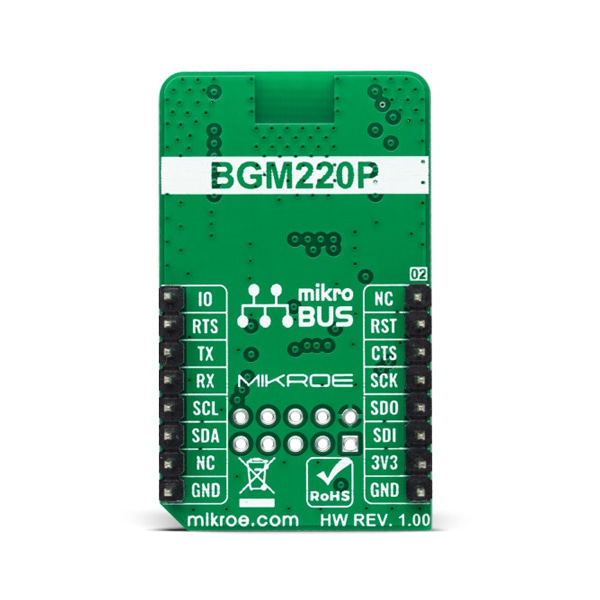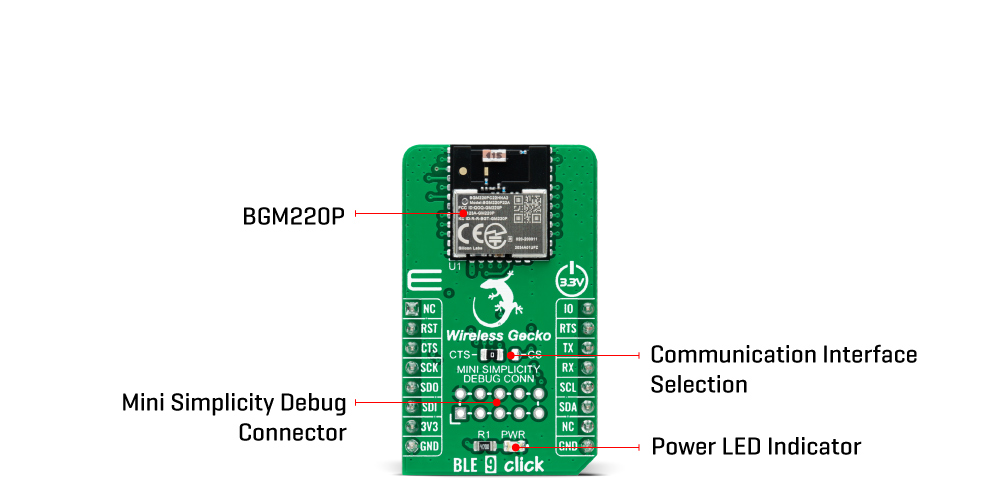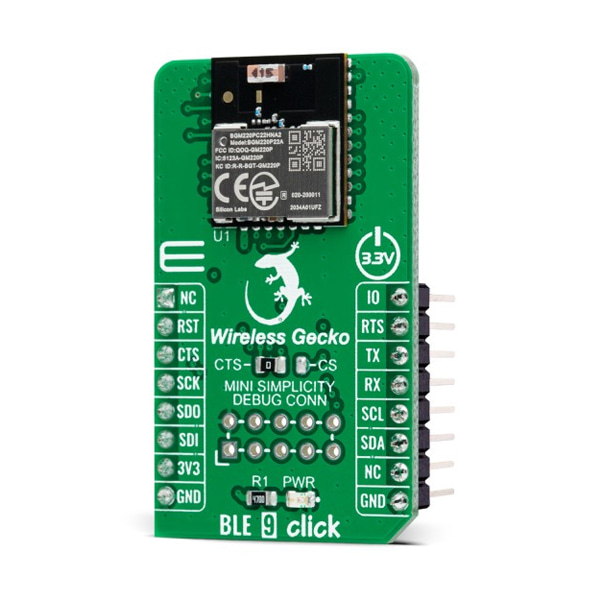블루투스 5.2 BLE 모듈 -BGM220P
(BLE 9 CLICK)

개요
- 본 제품은 블루투스 5.2 BLE 모듈 -BGM220P 입니다.
- BGM220P BLE IoT칩 기반으로 디자인된 제품으로 블루투스 5.2를 지원합니다.
- Bluetooth 5.2, direction-finding 및 Bluetooth Mesh Low Power Node protocol을 지원합니다.
특징
-
Type BT/BLE Applications Can be used for wireless networking in applications such as portable medical, connected home, asset tags and beacons, and more. On-board modules BGM220P, an RF performance Bluetooth Low Energy solution that provides BT/BLE connectivity for any embedded application from Silicon Labs. Key Features Bluetooth 5.2 Low-Energy (BLE) solution, firmware updates, enhanced security features, low power consumption, direction-finding, Bluetooth Mesh Low Power Node protocols to deliver industry-leading accuracy, and more. Interface I2C,SPI,UART Compatibility mikroBUS Click board size M (42.9 x 25.4 mm) Input Voltage 3.3V -
BLE 9 Click is based on the BGM220P, an RF performance Bluetooth Low Energy solution that provides BT/BLE connectivity for any embedded application from Silicon Labs. It supports Bluetooth 5.2, direction-finding, and Bluetooth Mesh Low Power Node protocols to deliver industry-leading accuracy. It comes with worldwide regulatory certifications and a fully-upgradeable software stack as advanced development and debugging tool. The BGM220P module combines the EFR32BG22 wireless System on a Chip (SoC), required decoupling capacitors and inductors, 38.4 MHz and 32.768 kHz crystals, RF matching circuit, and an integrated ceramic onboard chip antenna.

The EFR32BG22 SoC, inside the BGM220P module, includes an Arm Cortex-M33 processing core, up to 32Kb of RAM, up to 512kB of flash memory, and a 2.4GHz radio transceiver, offering up to 8dB output power. This Click board™ offers enhanced performance, security, and reliability to support IoT products running on Bluetooth networks.
BLE 9 Click communicates with MCU using the UART interface as its default communication protocol with the option for the users to use other interfaces such as SPI and I2C if they want to configure the module and write the library by themselves using these protocols. It also can be used in a stand-alone SoC configuration without an external host processor.
In addition to these protocol pins, this Click board™ also has serial UART connections labeled as CTS and RTS, routed on the CS and INT pins of the mikroBUS™ socket, as well as Reset pin provided and routed at the RST pin of the mikroBUS™ socket. An additional GPIO pin, labeled as IO routed on the PWM pin of the mikroBUS™ socket, is left for configuration purposes as desired by the user.
An onboard jumper selects the function of the CS mikroBUS™ pin between the SPI or UART communication pin. Selection is performed by positioning the SMD jumper to an appropriate position, labeled as CTS or CS. At the bottom of the BLE 9 Click is an additional header, the Mini Simplicity Debug Connector, which offers full support of debugging and programming capabilities. With this header, the user can use a serial wire debug interface for programming and debugging, using SWCLK and SWDIO pins, with Virtual UART COM port and Virtual UART-SWD-based interface also available through the SWD interface (SWDIO, SWCLK, and SWO).
This Click board™ is designed to be operated only with a 3.3V logic voltage level. A proper logic voltage level conversion should be performed before the Click board™ is used with MCUs with different logic levels.
